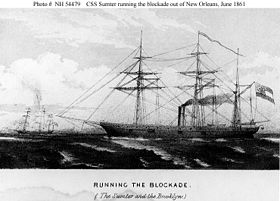Sumter (ship)
 The Sumter on a contemporary representation |
|
| Overview | |
|---|---|
| Keel laying | 1859 |
| 1. Period of service |
|
| Commissioning | June 3, 1861 as Sumter |
| Whereabouts | Sold to private on December 19, 1862 (new name: Gibraltar ) |
| Technical specifications | |
| displacement |
473 ts |
| length |
184 ft |
| width |
30 ft |
| Draft |
12 ft |
| crew |
18th |
| drive |
Sail / steam engine |
| speed |
10 knots |
| Armament |
1 × 8 inch; 4 × 32 pounders |
The Sumter was built in Philadelphia in 1859 for the "McConnell's New Orleans & Havana Line" as a barque- rigged merchant ship with an additional steam engine and named Habana . In April 1861 the ship was bought by the Confederate government in New Orleans . Then she was converted into an auxiliary cruiser and placed under the command of Raphael Semmes . Renamed Sumter , it entered the Confederate Navy on June 3, 1861, and at the end of the month the breakthrough through the blockade of the northern states off the mouth of the Mississippi .
In early July, the Sumter was able to run away from the sloop-of-war Brooklyn in a chase battle. In the waters around Cuba, the commercial disturber Confederate Navy succeeded in arresting eight merchant ships sailing under the Northern flag . This was followed by a trip south off the coast of Brazil , where it was possible to take two more US merchant ships east of Maranhão . Two more merchant ships were brought in in September and October.
During a coal takeover in Martinique in mid-November , the Sumter was blocked by the US Sloop of War Iroquois , but was able to escape at night and continue activities. The Sumter then moved into European waters and during this voyage brought another six enemy ships from November 1861 to January 1862.
On January 4, 1862, she anchored in Cádiz , but only received permission for a few minor repairs. They refused to use coal and forced them to move to Gibraltar .
After it became apparent that the necessary repairs could not be carried out, the ship was laid up in April 1862. Here she remained inactive for the rest of the year, under constant observation by ships of the US Navy, such as the sloop-of-war Kearsarge and the gunboat Chippewa . Commander Semmes and a number of the other officers were withdrawn and assigned to Alabama .
Although the Sumter had only a six-month career, she had seized 18 ships during this time, eight of them were burned, nine were dismissed because they did not carry contraband with them, one ship was seized a second time. The necessary efforts by the US fleet to track down the ship resulted in a fragmentation of forces and an associated weakening of the blockade, thereby doing the southern states cause a great service.
The Sumter was disarmed on December 19, 1862, sold to the company "Fraser-Trenholm", which renamed it Gibraltar and deployed it under the British flag from Liverpool as a blockade breaker to the Confederate States.
There are no detailed records of her use as a blockade breaker, it is only known that she called at least once under her new commander, Southern Captain EC Reid Wilmington , with two 22-ton Blakely cannons and ammunition on board. On the way back she took cotton with her. This information is only available because the US Consul protested in Liverpool against permission to leave the country - even if Nassau was specified as the port of destination . This protest took place days before the official clearance required to sail: "It is a ship with privileges that is not treated like other vessels in terms of compliance with rules and regulations." ( "She is one of the privileged class and not held down like other vessels to strict rules and made to conform to regulations. " ) which meant nothing more than an affront to the USA.
The further whereabouts of the ship is unclear, the son-in-law of the owner Mr. Trenholm left a note that she sank near the place where the Alabama sank, but without giving a date. The last (official) mention of it is in a report by the US Consul in Liverpool on July 10, 1864, which states that the "Pirate Sumter" is laid up in Birkenhead .
literature
- Raphael Semmes: The Cruise of the Alabama and the Sumter , Carleton, 1864, Digitized by Digital Scanning Incorporated, 2001, ISBN 1-58218-353-8 .
- The Cornhill Magazine, No. 6 (Jul-Dec 1862) pp. 187-205: "The Cruise of the Confederate Ship 'Sumter': (From the Private Journal of an Officer)".
Remarks
- ↑ as sloop-of-war warships with a battery deck and up to 18 guns were designated
- ↑ what happened to this is not known
- ↑ a common practice for blockade breakers during this war
Web links
History of Sumter (ship) in the Dictionary of American Naval Fighting Ships (English)